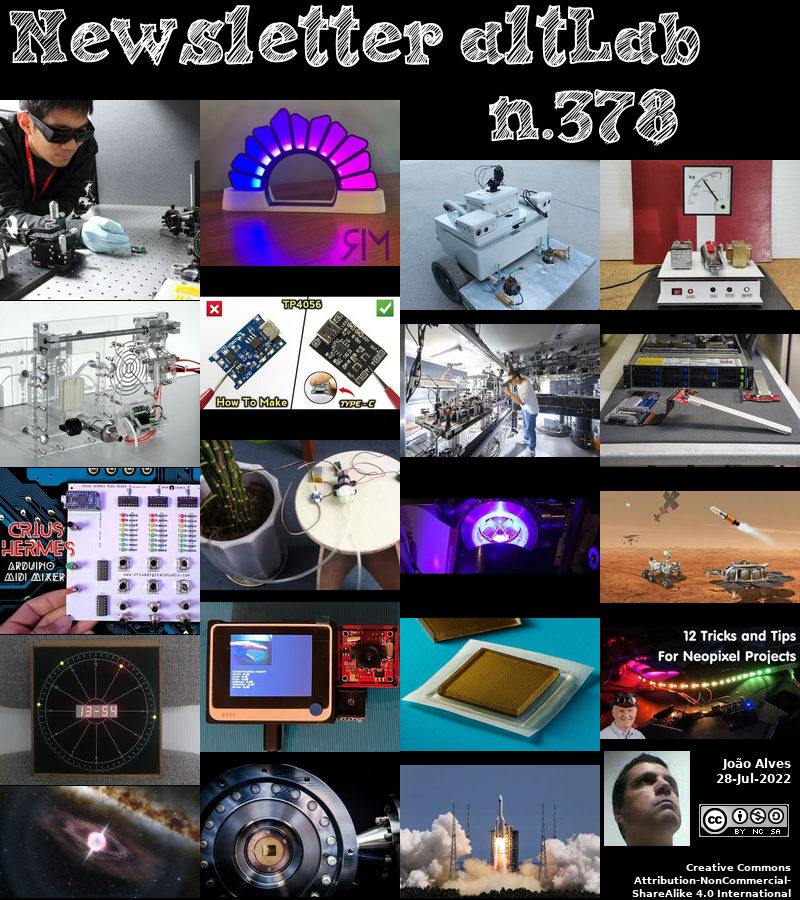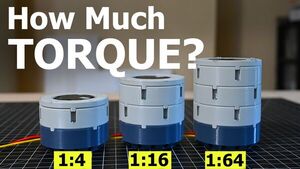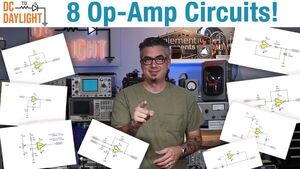2022-07-28 - Nº 378
Editorial
Esta é a Newsletter Nº 378 que se apresenta com o mesmo formato que as anteriores. Se gostar da Newsletter partilhe-a!
Todas as Newsletters encontram-se indexadas no link.
Esta Newsletter tem os seguintes tópicos:
Faz hoje anos que nascia, em 1907, o inventor e fabricante norte-americano Earl Tupper. Ele introduziu a Tupperware. Na década de 1930, Tupper inventou um material flexível e leve que foi utilizado para fazer máscaras de plástico de gás durante a Segunda Guerra Mundial. Ao trabalhar na DuPont (1937-38), ganhou experiência na concepção de plásticos e saiu por conta própria. Nos anos 40, os produtos plásticos tinham a reputação de serem frágeis, gordurosos, malcheirosos e geralmente pouco fiáveis. Primeiro, desenvolveu um método de purificação da escória preta de polietileno, um produto residual produzido em refinamento de petróleo, numa substância que era flexível, resistente, não porosa, não gordurosa e translúcida. Em segundo lugar, desenvolveu o selo Tupper, uma tampa hermética e estanque à água modelada na tampa para recipientes de tinta. Juntas, estas inovações lançaram as bases para o sucesso futuro da Tupperware como produto de consumo. A sua empresa teve grande sucesso ao comercializar através da ideia da Brownie Wise das partes da Tupperware.
Faz também hoje anos que nascia, em 1915, o físico norte-americano Charles H. Townes. Ele partilhou (com os físicos soviéticos Aleksandr M. Prokhorov e Nikolay G. Basov) o Prémio Nobel da Física de 1964 "pelo trabalho fundamental no campo da electrónica quântica, que levou à construção de osciladores e amplificadores baseados no princípio maser-laser". Tinha aplicado a física de microondas para estudar as interacções entre microondas e moléculas, produzindo espectros de microondas, que pensava poder ser utilizados para determinar a estrutura das moléculas, átomos e núcleos. Em vez disso, a partir deste trabalho, em 1951, concebeu a ideia do maser e perseguiu esse objectivo. No início de 1954, utilizando o gás amoníaco como meio, foram obtidos os primeiros resultados da amplificação e geração de ondas electromagnéticas por emissão estimulada. Cunharam a palavra maser para este dispositivo, um acrónimo que utiliza as letras iniciais de "Microwave Amplification by Stimulated Emission of Radiation" (Amplificação por Microondas por Emissão Estimulada de Radiação).
Por fim, faz hoje anos que nascia, em 1954, o matemático alemão Gerd Faltings. Ele recebeu a Medalha Fields de 1986 (a maior honra que um jovem matemático pode receber) principalmente pela sua prova da Conjectura de Mordell, que conseguiu utilizando métodos de geometria algébrica aritmética. Foi também estreitamente ligado ao trabalho que conduziu à prova final do Último Teorema de Fermat por Andrew Wiles. Em 1983, Faltings provou que para cada n > 2 há, no máximo, um número finito de inteiros de coprime x, y, z com xn + yn = zn. Este foi um passo importante, mas uma prova de que o número finito era 0 em todos os casos não parecia provável que se seguisse, alargando os argumentos da Falting. No entanto, Faltings foi a pessoa natural a quem Wiles recorreu quando quis uma opinião sobre a correcção da sua reparação da sua prova do último teorema de Fermat em 1994.
Em 1858, as impressões digitais foram utilizadas pela primeira vez como meio de identificação.
Em 1883, o Sr. Ferry pedalou um triciclo de água através do Canal da Mancha. Partiu de Dover cerca das nove horas da manhã, e chegou a Calais em menos de oito horas. A distância em linha recta era de vinte milhas, mas por causa das correntes, o esforço necessário foi consideravelmente aumentado. A construção do seu veículo foi ilustrada em La Nature. Rodas de pás volumosas (provavelmente precisando de mais deslocamento do que o mostrado) substituem as rodas de um triciclo terrestre. A pequena roda atrás actuava como um leme.
Na Newsletter desta semana apresentamos diversas noticias, artigos científicos, projetos de maker e alguns vídeos interessantes. São apresentadas as revistas Hackspace Magazine nº57 e a MagPI nº120 de Agosto.
 João Alves ([email protected])
João Alves ([email protected])
O conteúdo da Newsletter encontra-se sob a licença  Creative Commons Attribution-NonCommercial-ShareAlike 4.0 International License.
Creative Commons Attribution-NonCommercial-ShareAlike 4.0 International License.
Novidades da Semana
Outras Notícias
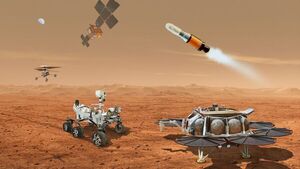
NASA Will Inspire World When It Returns Mars Samples to Earth in 2033
"This advanced mission architecture will include two sample recovery helicopters. NASA has finished the system requirements review for its Mars Sample Return Program, which is nearing completion of the conceptual design phase. During this phase, the program team evaluated and refined the architecture to return the scientifically selected samples, which are currently in the collection process by NASA’s Perseverance rover in the Red Planet’s Jezero Crater. The architecture for the campaign, which includes contributions from the European Space Agency (ESA), is expected to reduce the complexity of future missions and increase probability of success. “The conceptual design phase is when every facet of a mission plan gets put under a microscope,” said Thomas Zurbuchen, associate administrator for science at NASA Headquarters in Washington. “There are some significant and advantageous changes to the plan, which can be directly attributed to Perseverance’s recent successes at Jezero and the amazing performance of our Mars helicopter.” This advanced mission architecture takes into consideration a recently updated analysis of Perseverance’s expected longevity." [...]

Nexperia reveals wafer-level 12 & 30V MOSFETs with market-leading efficiency
"Three new devices in DSN1006 and DSN1010 save power and simplify thermal management in space-constrained applications Nexperia, the expert in essential semiconductors, has introduced the PMCB60XN and PMCB60XNE 30V N-channel small-signal trench MOSFETs, with market-leading RDS(on) in the ultra-compact wafer-level DSN1006 package, to make energy go further where space is tight and battery runtime is critical. Ideal for highly miniaturized electronics like smartphones, smart watches, hearing aids, and earphones, the new MOSFETs support the trend towards greater intelligence and richer functionality that raise system power demand. With RDS(on) up to 25% better than competing devices, they minimize energy losses and increase efficiency in load switching and battery management. Their superior performance also reduces self heating thereby enhancing user comfort in wearable devices. Specifically, the PMCB60XN and PMCB60XNE have maximum RDS(on) of 50mΩ and 55mΩ respectively, at VGS = 4.5V. This gives them the lowest on-resistance per die area among similar 30V MOSFETs in the market." [...]

Toshiba’s New SiC MOSFETs Delivers Low On-Resistance and Significantly Reduced Switching Loss
"Toshiba Electronic Devices & Storage Corporation (“Toshiba”) has developed silicon carbide (SiC) MOSFETs with low on-resistance and significantly reduced switching loss—about 20% lower than in its second-generation SiC MOSFETs. Power devices are essential components for managing and reducing power consumption in all kinds of electronic equipment, and for achieving a carbon neutral society. SiC is widely seen as the next generation material for power devices, as it delivers higher voltages and lower losses than silicon. While SiC power devices are now mainly utilized in inverters for trains, wider application is on the horizon, in vehicle electrification and the miniaturization of industrial equipment. However, the adoption and market growth of SiC devices have been held back by reliability issues. Toshiba has solved this problem by adopting a structure in which a Schottky Barrier Diode (SBD) is placed in parallel with the PN diode inside the SiC MOSFET of the second-generation product." [...]
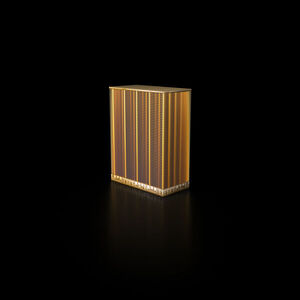
Micron Ships World’s First 232-Layer NAND, Extends Technology Leadership
"Latest innovations deliver TLC NAND with the highest performance and wafer density, all in the industry's smallest package Micron Technology, Inc. (Nasdaq: MU), today announced that it has begun volume production of the world’s first 232-layer NAND, built with industry-leading innovations to drive unprecedented performance for storage solutions. It features the industry’s highest areal density and delivers higher capacity and improved energy efficiency over previous generations of Micron NAND, to enable best-in-class support of the most data-intensive use cases from client to cloud. “Micron’s 232-layer NAND is a watershed moment for storage innovation as first proof of the capability to scale 3D NAND to more than 200 layers in production,” said Scott DeBoer, executive vice president of technology and products at Micron. “This groundbreaking technology required extensive innovation, including advanced process capabilities to create high aspect ratio structures, novel materials advancements and leading-edge design enhancements that build on our market-leading 176-layer NAND technology.” Leading-Edge Technology Delivers Unrivaled Performance As the world generates more data, customers must expand their storage capacity and performance while reducing energy consumption and meeting more stringent environmental sustainability requirements. Micron’s 232-layer NAND technology provides the high-performance storage necessary to support advanced solutions and real-time services required in data center and automotive applications, as well as responsive, immersive experiences on mobile devices, consumer electronics and PCs. This technology node enables the introduction of the industry’s fastest NAND I/O speed ‒ 2.4 gigabytes per second (GB/s) ‒ to meet the low-latency and high-throughput needs of data-centric workloads such as artificial intelligence and machine learning, unstructured databases and real-time analytics, and cloud computing.1 That speed represents a 50% faster data transfer than the fastest interface enabled on Micron’s 176-layer node.2 Micron 232-layer NAND also delivers up to 100% higher write bandwidth and more than 75% higher read bandwidth per die than the prior generation.2 These per-die benefits translate to performance and energy efficiency gains in SSDs and embedded NAND solutions." [...]
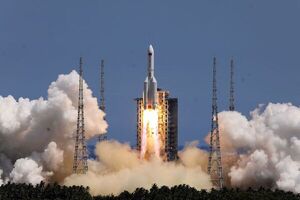
China launches second space station module, Wentian
"China on Sunday launched the second of three modules to its permanent space station, in one of the final missions needed to complete the orbiting outpost by year's end. A live feed on state broadcaster CCTV showed the 23-tonne Wentian ("Quest for the Heavens") laboratory module launching on the back of China's most powerful rocket, the Long March 5B, at 2:22 p.m. (0622 GMT) from the Wenchang Space Launch Center on the southern island of Hainan. Space agency staff, seen on the live feed observing the progress of the launch from a control room, cheered and applauded when the Wentian separated from the rocket about 10 minutes after the launch. The launch was "a complete success", CCTV reported shortly after. China began constructing the space station in April 2021 with the launch of the Tianhe module, the main living quarters, in the first of 11 crewed and uncrewed missions in the undertaking. The Wentian lab module, 17.9 metres (59 feet) long, will be where astronauts can carry out scientific experiments, along with the other lab module yet to be launched - Mengtian ("Dreaming of the Heavens")." [...]
Ciência e Tecnologia
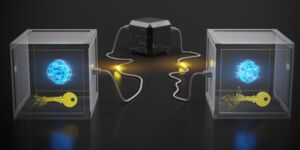
A key role for quantum entanglement
"A method known as quantum key distribution has long held the promise of communication security unattainable in conventional cryptography. An international team of scientists, including ETH physicists, has now demonstrated experimentally, for the first time, an approach to quantum key distribution that uses high-quality quantum entanglement to provide much broader security guarantees than previous schemes. The art of cryptography is to skilfully transform messages so that they become meaningless to everyone but the intended recipients. Modern cryptographic schemes, such as those underpinning digital commerce, prevent adversaries from illegitimately deciphering messages — say, credit-card information — by requiring them to perform mathematical operations that consume a prohibitively large amount of computational power. Starting from the 1980s, however, ingenious theoretical concepts have been introduced in which security does not depend on the eavesdropper’s finite number-crunching capabilities. Instead, basic laws of quantum physics limit how much information, if any, an adversary can ultimately intercept." [...]
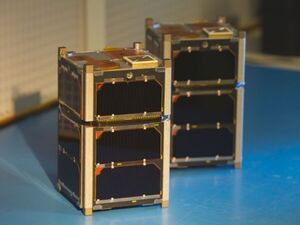
UNH Research Finds Tiny CubeSats Can Offer a Big Scientific Bang for the Buck
"Good things can indeed come in small packages, especially when it relates to satellite technology. Scientists at the University of New Hampshire have found that innovative miniature CubeSats, usually no larger than a box of tissues, can be just as effective in performing important space science missions as their larger counterparts, often with tolerable risk, significantly lower cost and comparatively high scientific return. “We wanted to see if CubeSats, which are gaining popularity in space research, can hold their own by producing significant, quality science to help better understand space weather which can wreak havoc on space-age technologies such as GPS and telecommunications, produce radiation risks to astronauts, and even cause power outages on Earth through disruptions of the power grid,” said Harlan Spence, professor of physics and lead author. In their study, recently published in the journal Space Weather, the researchers compared five successful space weather CubeSat missions that operated over the last 10 years with five larger NASA space science missions flown during the same time period. First, they looked at size and cost. Each of the five CubeSats weighed about three kilograms (less than a gallon of milk) and the missions cost just over a million dollars, running between $1.2 million and $1.3 million." [...]
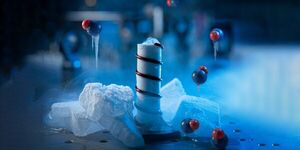
The big chill: A microwave freezer for molecules
"A team led by quantum physicist Immanuel Bloch has developed a new method to cool gases of polar molecules to near absolute zero. This paves the way for studying quantum effects of exotic forms of matter. When a highly diluted gas is cooled to extremely low temperatures, bizarre properties are revealed. Thus, some gases form a so-called Bose-Einstein condensate - a type of matter in which all atoms move in unison. Another example is supersolidity: a state in which matter behaves like a frictionless fluid with a periodic structure. Physicists expect to find particularly diverse and revealing forms of quantum matter when cooling gases consisting of polar molecules." [...]

Programming pH
"pH — the concentration of protons in a watery solution — indicates how acidic the solution is. It regulates a broad range of natural and engineered chemical processes, including the synthesis of designed DNA sequences for applications in biotechnology. Changing the pH uniformly across an entire water-based solution is a standard practice in chemistry. But what if researchers could create an array of localized pH regions where protons are more intensely concentrated than in other parts of the solution? This would allow them to perform pH-regulated chemistry at each of those locations in parallel, dramatically increasing the experimental throughput and speeding up processes in DNA synthesis, which has applications in genomics, synthetic biology, vaccine development and other therapies, and data storage. But localizing pH is a challenge because protons spread out fast in a water-based solution." [...]
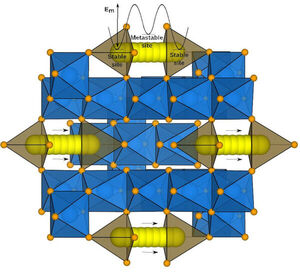
Computer simulations aid scientists in gauging battery performance
"A crucial but poorly-studied parameter that dictates battery performance is the migration barrier. It determines the rate at which ions move through an electrode inside the battery, and ultimately the rate at which it charges or discharges. Because it is hard to measure the migration barrier in the lab, researchers typically use different computer simulations or approximations to quickly predict migration barrier values. However, very few of these simulations have been experimentally verified so far. In a new study, researchers at the Indian Institute of Science (IISc) and their collaborators comprehensively analysed widely-used computational techniques, and verified their predictions of the migration barrier values against actual data observed in lab measurements. Based on their analysis, the team proposes a set of robust guidelines to help researchers choose the most accurate computational framework for testing materials that can be used to develop highly efficient batteries in the future." [...]

Los Alamos National Laboratory and SK hynix to demonstrate first-of-a-kind ordered Key-value Store Computational Storage Device
"Los Alamos National Laboratory and SK hynix, a leading semiconductor innovator and memory/flash manufacturer, will demonstrate the world’s first ordered Key Value Store Computational Storage Device (KV-CSD), a result of a collaboration between Los Alamos’ High Performance Computing division and SK hynix. The Laboratory is moving their large-scale simulation input-output (I/O) from file-based to record- and column-based, which enables analytics to be done using tools from the big data/analytics community. The Laboratory has shown 1000X speedups on analysis of simulation output by leveraging indexing to achieve data reduction on query via their DeltaFS parallel-file system technology. These indexing capabilities enable ordered range queries and point queries. Pushing indexing capabilities closer to the storage devices can save orders of magnitude of data movement upon retrieval for analysis. In a first for the nonvolatile memory express industry, system researchers at SK hynix achieved pushing indexing capability functionality into the new KV-CSD prototype to mate with Laboratory security science applications." [...]

First demonstration of a secure quantum network with untrusted quantum devices
"An international team comprising researchers from the National University of Singapore (NUS) and LMU Munich (LMU) have, for the first time, successfully demonstrated a new form of quantum key distribution (QKD) that is secure even if the users are not privy to the underlying quantum hardware. The work paves the way for a more secure and open quantum internet. It was published in the scientific journal Nature on 27 July 2022 and the collaboration was jointly led by Assistant Professor Charles Lim from NUS and Professor Harald Weinfurter from LMU, who oversaw the project’s theory and experiment respectively. The distribution of secret keys over a public channel is a fundamental requirement for secure communication. Today, secret key exchange methods assume that certain mathematical problems are hard to solve using state-of-the-art computing solutions. However, given the rapid development of next-generation computing technologies such as quantum computing, this approach may not be the most appropriate in applications where long-term security is highly valued." [...]
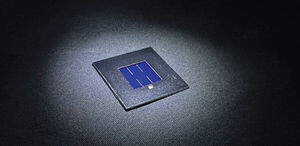
One more slice to drive the solar stack
"An extra metal fluoride layer facilitates charge separation and boosts performance in perovskite–silicon tandem solar cells. Inserting a metal fluoride layer in multilayered perovskite–silicon tandem solar cells can stall charge recombination and enhance performance, KAUST researchers have found. Tandem solar cells that combine perovskite and silicon-based subcells in one device are expected to better capture and convert sunlight into electricity than their conventional single-junction silicon analogs at a lower cost. However, when sunlight strikes the perovskite subcell, the resulting pairs of electrons and positively charged holes tend to recombine at the interface between perovskite and the electron-transport layer. Also, a mismatch between energy levels at this interface hinders electron separation within the cell. Cumulatively, these problems lower the maximum operating voltage available, or open-circuit voltage, of the tandem cells and limit device performance." [...]
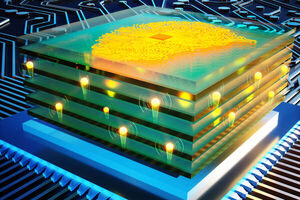
New hardware offers faster computation for artificial intelligence, with much less energy
"Engineers working on “analog deep learning” have found a way to propel protons through solids at unprecedented speeds. As scientists push the boundaries of machine learning, the amount of time, energy, and money required to train increasingly complex neural network models is skyrocketing. A new area of artificial intelligence called analog deep learning promises faster computation with a fraction of the energy usage. Programmable resistors are the key building blocks in analog deep learning, just like transistors are the core elements for digital processors. By repeating arrays of programmable resistors in complex layers, researchers can create a network of analog artificial “neurons” and “synapses” that execute computations just like a digital neural network. This network can then be trained to achieve complex AI tasks like image recognition and natural language processing." [...]

Anti-butterfly effect enables new benchmarking of quantum-computer performance
"Running a quantum system backward, then forward in time distinguishes information leaks from the desired information scrambling. Research drawing on the quantum “anti-butterfly effect” solves a longstanding experimental problem in physics and establishes a method for benchmarking the performance of quantum computers. “Using the simple, robust protocol we developed, we can determine the degree to which quantum computers can effectively process information, and it applies to information loss in other complex quantum systems, too,” said Bin Yan, a quantum theorist at Los Alamos National Laboratory. Yan is corresponding author of the paper on benchmarking information scrambling published today in Physical Review Letters. “Our protocol quantifies information scrambling in a quantum system and unambiguously distinguishes it from fake positive signals in the noisy background caused by quantum decoherence,” he said. Noise in the form of decoherence erases all the quantum information in a complex system such as a quantum computer as it couples with the surrounding environment." [...]
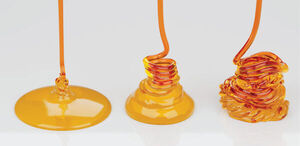
Watching viscous flow, but faster
"A combination of efficient math and parallel computation accelerates the modeling of viscous liquid flow. By redesigning how fluids are simulated, KAUST researchers have demonstrated a more than tenfold speed increase on the previous state of the art for slow-flowing viscous liquids. Modeling the behavior of liquids is important for a wide range of applications, from industrial processes and medical devices to computer graphics and visual simulations. However, despite many years of development and known physics dating back over 100 years, the ability to accurately simulate liquid flow remains one of the most computationally challenging aspects of creating digital replicas of the real world. This is because the flow and behavior of liquids is determined by both the pressure distribution through the liquid and, in the case of thick viscous liquids, the pressure-dependent internal resistance to that flow. Precisely calculating these complex and time-varying distributions is very computationally intensive, and so many optimization schemes have been developed to speed up this calculation process at the expense of accuracy." [...]

MIT engineers develop stickers that can see inside the body
"New stamp-sized ultrasound adhesives produce clear images of heart, lungs, and other internal organs. Ultrasound imaging is a safe and noninvasive window into the body’s workings, providing clinicians with live images of a patient’s internal organs. To capture these images, trained technicians manipulate ultrasound wands and probes to direct sound waves into the body. These waves reflect back out to produce high-resolution images of a patient’s heart, lungs, and other deep organs. Currently, ultrasound imaging requires bulky and specialized equipment available only in hospitals and doctor’s offices. But a new design by MIT engineers might make the technology as wearable and accessible as buying Band-Aids at the pharmacy." [...]

UMD Scientists Help Uncover Origins of Castaway Gamma-ray Bursts
"These enigmatic bursts of energy have been traced back to previously undiscovered galaxies in the early Universe An international team of astronomers found that certain short gamma-ray bursts (GRBs) did not originate in the vastness of intergalactic space as they initially seemed to appear. A deeper multi-observatory study instead found that these perceived castaway GRBs actually formed in remarkably distant—and therefore faint—galaxies up to 10 billion light-years away. The study was published on July 26, 2022, in the Monthly Notices of the Royal Astronomical Society. A number of GRBs appear as lonely flashes of intense energy far from any obvious galactic home, which has raised questions about their true origins and distances. Using data from some of the most powerful telescopes on Earth and in space, including the National Science Foundation’s (NSF) Gemini telescopes, astronomers were able to solve this mystery. “Many short GRBs are found in bright galaxies relatively close to us, but some of them appear to have no corresponding galactic home,” said Brendan O’Connor, an astronomer at the University of Maryland and George Washington University." [...]
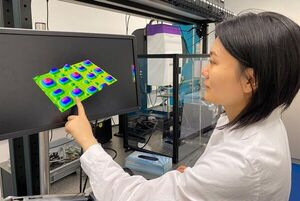
Artificial skin sweats on command
"The sophisticated artificial skin sweats where and how much the researchers want it to. This was reported in an Angewandte Chemie article by Danqing Liu and first author Yuanyuan Zhan. Following the breakthrough with their first sweating artificial skin two years ago, Danqing Liu’s multidisciplinary team hasn’t been sitting still. Their goal: an artificial skin that sweats as naturally as possible. They have succeeded in this, as can be read in their article in Angewandte Chemie. There, they explain how they managed to be the first team in the world to be able to accurately control where, when and how much an artificial skin sweats and also where the liquid collects." [...]

Researchers 3D print sensors for satellites
"Cheap and quick to produce, these digitally manufactured plasma sensors could help scientists predict the weather or study climate change. MIT scientists have created the first completely digitally manufactured plasma sensors for orbiting spacecraft. These plasma sensors, also known as retarding potential analyzers (RPAs), are used by satellites to determine the chemical composition and ion energy distribution of the atmosphere. The 3D-printed and laser-cut hardware performed as well as state-of-the-art semiconductor plasma sensors that are manufactured in a cleanroom, which makes them expensive and requires weeks of intricate fabrication. By contrast, the 3D-printed sensors can be produced for tens of dollars in a matter of days. Due to their low cost and speedy production, the sensors are ideal for CubeSats." [...]

Reproducibility is the best predictor of generalizability
"An international team of researchers was recently able to show that research results from the field of strategic management in some cases generalizes to new time periods and new geographies. The decisive criterion for this is the reproducibility of a study: studies whose results can be obtained again using the same data also tend to generalize to new times and places. They also find that independent scientists are able to forecast which results would be supported in new tests. Research in physics, biology or other natural sciences uncovers regularities that help us to better understand the world around us. But what about the social sciences, which deal with individual or collective human behavior? Can cross-contextual regularities be identified here as well?" [...]

Explained: How to tell if artificial intelligence is working the way we want it to
"“Interpretability methods” seek to shed light on how machine-learning models make predictions, but researchers say to proceed with caution. About a decade ago, deep-learning models started achieving superhuman results on all sorts of tasks, from beating world-champion board game players to outperforming doctors at diagnosing breast cancer. These powerful deep-learning models are usually based on artificial neural networks, which were first proposed in the 1940s and have become a popular type of machine learning. A computer learns to process data using layers of interconnected nodes, or neurons, that mimic the human brain. As the field of machine learning has grown, artificial neural networks have grown along with it. Deep-learning models are now often composed of millions or billions of interconnected nodes in many layers that are trained to perform detection or classification tasks using vast amounts of data." [...]
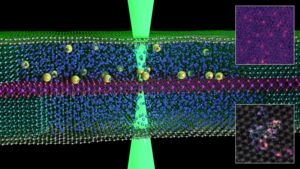
Graphene scientists capture first images of atoms ‘swimming’ in liquid
"Graphene scientists from The University of Manchester have created a novel ‘nano-petri dish’ using two-dimensional (2D) materials to create a new method of observing how atoms move in liquid. Publishing in the journal, Nature, the team led by researchers based at the National Graphene Institute (NGI) used stacks of 2D materials including graphene to trap liquid in order to further understand how the presence of liquid changes the behaviour of the solid. The team were able to capture images of single atoms ‘swimming’ in liquid for the first time. The findings could have widespread impact on the future development of green technologies such as hydrogen production. When a solid surface is in contact with a liquid, both substances change their configuration in response to the proximity of the other. Such atomic scale interactions at solid-liquid interfaces govern the behaviour of batteries and fuel cells for clean electricity generation, as well as determining the efficiency of clean water generation and underpinning many biological processes." [...]
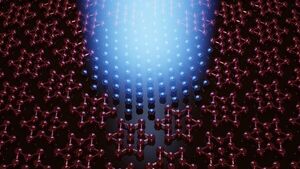
Scientists capture first-ever view of a hidden quantum phase in a 2D crystal
"Single-shot spectroscopy techniques provide researchers with a new understanding of a mysterious light-driven process. The development of high-speed strobe-flash photography in the 1960s by the late MIT professor Harold “Doc” Edgerton allowed us to visualize events too fast for the eye — a bullet piercing an apple, or a droplet hitting a pool of milk. Now, by using a suite of advanced spectroscopic tools, scientists at MIT and University of Texas at Austin have for the first time captured snapshots of a light-induced metastable phase hidden from the equilibrium universe. By using single-shot spectroscopy techniques on a 2D crystal with nanoscale modulations of electron density, they were able to view this transition in real-time. “With this work, we are showing the birth and evolution of a hidden quantum phase induced by an ultrashort laser pulse in an electronically modulated crystal,” says Frank Gao PhD ’22, co-lead author on a paper about the work who is currently a postdoc at UT Austin. “Usually, shining lasers on materials is the same as heating them, but not in this case,” adds Zhuquan Zhang, co-lead author and current MIT graduate student in chemistry." [...]

AI tackles the challenge of materials structure prediction
"Researchers have designed a machine learning method that can predict the structure of new materials with five times the efficiency of the current standard, removing a key roadblock in developing advanced materials for applications such as energy storage and photovoltaics. The researchers, from Cambridge and Linkoping Universities, have designed a way to predict the structure of materials given its constitutive elements. The results are reported in the journal Science Advances. The arrangement of atoms in a material determines its properties. The ability to predict this arrangement computationally for different combinations of elements, without having to make the material in the lab, would enable researchers to quickly design and improve materials. This paves the way for advances such as better batteries and photovoltaics." [...]

Rice engineers get a grip with ‘necrobotic’ spiders
"Lab manipulates dead spiders’ legs with a puff of air to serve as grabbers. Rice University mechanical engineers are showing how to repurpose deceased spiders as mechanical grippers that can blend into natural environments while picking up objects, like other insects, that outweigh them. Why? “It happens to be the case that the spider, after it’s deceased, is the perfect architecture for small scale, naturally derived grippers,” said Daniel Preston of Rice’s George R. Brown School of Engineering. An open-access study in Advanced Science outlines the process by which Preston and lead author Faye Yap harnessed a spider’s physiology in a first step toward a novel area of research they call “necrobotics.” Preston’s lab specializes in soft robotic systems that often use nontraditional materials, as opposed to hard plastics, metals and electronics. “We use all kinds of interesting new materials like hydrogels and elastomers that can be actuated by things like chemical reactions, pneumatics and light,” he said." [...]

New Photoacoustic Endoscope Fits Inside a Needle
"Tiny imaging device lays groundwork for high-resolution 3D imaging during clinical procedures Researchers have created a photoacoustic imaging endoscope probe that can fit inside a medical needle with an inner diameter of just 0.6 millimeters. Photoacoustic imaging, which combines light and sound to create 3D images, can provide important clinical information, but until now the instruments have been either too bulky or too slow for practical use as forward-viewing endoscopes. “Traditional light-based endoscopes can only resolve tissue anatomical information on the surface and tend to have large footprints,” said Wenfeng Xia, leader of the research team from the King’s College London School of Biomedical Engineering & Imaging Sciences. “Our new thin endoscope can resolve subcellular-scale tissue structural and molecular information in 3D in real-time and is small enough to be integrated with interventional medical devices that would allow clinicians to characterize tissue during a procedure.” The ultra-thin endoscope was developed through a close collaboration between King’s College London and University College London, both in the UK, and is described in the Optica Publishing Group journal Biomedical Optics Express. It consists of two optical fibers each roughly the diameter of a human hair. “The imaging speed of this photoacoustic endomicroscopy probe is two orders of magnitude higher than those previously reported,” said Xia." [...]

New Glass-Ceramic Emits Light When Under Mechanical Stress
"Transparent glassy material could be used to provide a light-based readout of stress in the body or buildings Researchers have created a new glass-ceramic that emits light in response to mechanical stress, a property known as mechanoluminescence. With further development, the new material could be used to create a light source that is switched on by mechanical stress. This could be useful for monitoring stress in artificial joints in the body or providing warnings of dangerous stress or fractures in buildings, bridges and other structures. “Most materials exhibiting mechanoluminescence have been made as powders, which aren’t very versatile,” said research team leader Lothar Wondraczek from Friedrich Schiller University Jena in Germany. “We designed a glass-ceramic material with mechanoluminescence, which allows glass-like processing approaches to be used to form virtually any shape — including fiber, beads or microspheres — that can be incorporated into various components and devices.” The research is reported in a special issue of Optical Materials Express commemorating the United Nations International Year of Glass 2022, which celebrates the essential role that glass plays in society. The new highly transparent glass-ceramic is made from chromium-doped zinc gallate (ZGO) crystals embedded in a potassium germanate glass matrix." [...]

Learning some new steps in the energy conversion dance
"At the heart of energy conversion, electrons and protons move in an intricate, coordinated dance. Chemists at Yale and in Sweden say they may have learned the steps to a new, photo-chemical rhumba. The discovery, published in the journal Science, could provide insights into the way the natural world converts solar energy into fuel, such as in photosynthesis. That knowledge may aid in the design of new solar energy technology and solar cells. “Although it is rare to discover a new, fundamental type of mechanism, this molecular system was primed to reveal such intriguing behavior,” said Sharon Hammes-Schiffer, Sterling Professor of Chemistry at Yale. “This work was only possible through a strong collaboration between theory and experiment.” Hammes-Schiffer is co-corresponding author of the study, along with James Mayer, the Charlotte Fitch Roberts Professor of Chemistry at Yale, and Leif Hammarström, a chemistry professor at Uppsala University, in Sweden." [...]
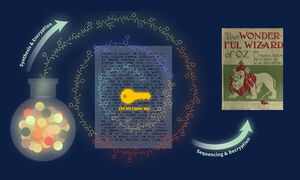
Scientists Encode “Wizard of Oz” in a Vanishingly Small Plastic
"Imagine being able to hide an extremely complex encryption password or detailed financial information for an organization inside the chemical structure of ink. It might sound like something out of a spy movie, but scientists at The University of Texas at Austin and the University of Massachusetts Lowell recently proved it possible. In a paper out today in the journal ACS Central Science, researchers outlined how they were able to take a 256-bit encryption key and encode it into a plastic-like material they synthesized in the lab, resulting in a new storage medium for encrypting a large data set. "When it comes to information storage, we're looking for ways to store data in the smallest amount of space and in a format that is durable and readable," said Eric Anslyn, a UT Austin chemistry professor and corresponding author on the paper. To prove their technique for storing data, Anslyn, collaborating with UMass Lowell's James Reuther and other researchers, encrypted a copy of The Wonderful Wizard of Oz by L. Frank Baum. The 256-bit encryption key is virtually impossible to break by even the fastest computers." [...]

Explosive volcanic eruption produced rare mineral on Mars
"Researchers publish scenario that explains 2016 discovery by NASA’s Curiosity rover Planetary scientists from Rice University, NASA’s Johnson Space Center and the California Institute of Technology have an answer to a mystery that’s puzzled the Mars research community since NASA’s Curiosity rover discovered a mineral called tridymite in Gale Crater in 2016. Tridymite is a high-temperature, low-pressure form of quartz that is extremely rare on Earth, and it wasn’t immediately clear how a concentrated chunk of it ended up in the crater.Gale Crater was chosen as Curiosity’s landing site due to the likelihood that it once held liquid water, and Curiosity found evidence that confirmed Gale Crater was a lake as recently as 1 billion years ago. “The discovery of tridymite in a mudstone in Gale Crater is one of the most surprising observations that the Curiosity rover has made in 10 years of exploring Mars,” said Rice’s Kirsten Siebach, co-author of a study published online in Earth and Planetary Science Letters. “Tridymite is usually associated with quartz-forming, explosive, evolved volcanic systems on Earth, but we found it in the bottom of an ancient lake on Mars, where most of the volcanoes are very primitive.” Siebach, an assistant professor in Rice’s Department of Earth, Environmental and Planetary Sciences, is a mission specialist on NASA’s Curiosity team. To suss out the answer to the mystery, she partnered with two postdoctoral researchers in her Rice research group, Valerie Payré and Michael Thorpe, NASA’s Elizabeth Rampe and Caltech’s Paula Antoshechkina. Payré, the study’s lead author, is now at Northern Arizona University and preparing to join the faculty of the University of Iowa in the fall." [...]

Tetrahedrons assemble! Three-sided pyramids form 2D structures
"Bottom-up construction with a 2D twist could yield novel materials Tetrahedron-shaped nanoparticles are interesting enough by themselves, but under the right circumstances, Rice University scientists have discovered they do something remarkable. While doing a routine check on a batch of tiny gold tetrahedrons, Rice chemist Matthew Jones and graduate student Zhihua Cheng found their microscopic particles had the unanticipated ability to arrange themselves into 2D chiral superstructures. The discovery, which is detailed in a new study in Nature Communications, is likely the first-known spontaneous self-assembly of a planar chiral structure, Jones said. Chiral structures are mirror opposites, similar forms, like right and left hands, that can’t be superimposed on one another. It’s an important distinction in drug design, where chiral molecules may be therapeutic in one handedness and toxic in the other. Tetrahedrons themselves are not chiral — that is, they can be superimposed on their mirror images." [...]
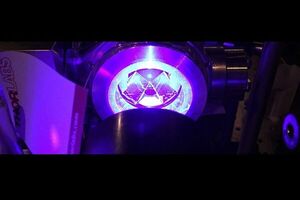
Next generation atomic clocks are a step closer to real world applications
"Quantum clocks are shrinking, thanks to new technologies developed at the University of Birmingham-led UK Quantum Technology Hub Sensors and Timing. Working in collaboration with and partly funded by the UK’s Defence Science and Technology Laboratory (Dstl), a team of quantum physicists have devised new approaches that not only reduce the size of their clock, but also make it robust enough to be transported out of the laboratory and employed in the ‘real world’. Quantum – or atomic – clocks are widely seen as essential for increasingly precise approaches to areas such as online communications across the world, navigation systems, or global trading in stocks, where fractions of seconds could make a huge economic difference. Atomic clocks with optical clock frequencies can be 10,000 times more accurate than their microwave counterparts, opening up the possibility of redefining the standard (SI) unit of measurement. Even more advanced optical clocks could one day make a significant difference both in everyday life and in fundamental science. By allowing longer periods between needing to resynchronise than other kinds of clock, they offer increased resilience for national timing infrastructure and unlock future positioning and navigation applications for autonomous vehicles." [...]

Magnetic quantum material broadens platform for probing next-gen information technologies
"Scientists at the Department of Energy’s Oak Ridge National Laboratory used neutron scattering to determine whether a specific material’s atomic structure could host a novel state of matter called a spiral spin liquid. By tracking tiny magnetic moments known as “spins” on the honeycomb lattice of a layered iron trichloride magnet, the team found the first 2D system to host a spiral spin liquid. The discovery provides a test bed for future studies of physics phenomena that may drive next-generation information technologies. These include fractons, or collective quantized vibrations that may prove promising in quantum computing, and skyrmions, or novel magnetic spin textures that could advance high-density data storage. “Materials hosting spiral spin liquids are particularly exciting due to their potential to be used to generate quantum spin liquids, spin textures and fracton excitations,” said ORNL’s Shang Gao, who led the study published in Physical Review Letters. A long-held theory predicted that the honeycomb lattice can host a spiral spin liquid – a novel phase of matter in which spins form fluctuating corkscrew-like structures." [...]
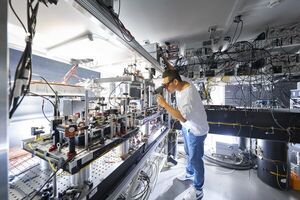
Quantum cryptography: Hacking futile
"An international team led by LMU physicist Harald Weinfurter has successfully implemented an advanced form of quantum cryptography for the first time. Encryption is more secure against hacking attempts. The Internet is teeming with highly sensitive information. Sophisticated encryption techniques generally ensure that such content cannot be intercepted and read. But in the future high-performance quantum computers could crack these keys in a matter of seconds. It is just as well, then, that quantum mechanical techniques not only enable new, much faster algorithms, but also exceedingly effective cryptography." [...]

Strange New Phase of Matter Created in Quantum Computer Acts Like It Has Two Time Dimensions
"By subjecting a quantum computer’s qubits to quasi-rhythmic laser pulses based on the Fibonacci sequence, physicists demonstrated a way of storing quantum information that is less prone to errors. By shining a laser pulse sequence inspired by the Fibonacci numbers at atoms inside a quantum computer, physicists have created a remarkable, never-before-seen phase of matter. The phase has the benefits of two time dimensions despite there still being only one singular flow of time, the physicists report July 20 in Nature. This mind-bending property offers a sought-after benefit: Information stored in the phase is far more protected against errors than with alternative setups currently used in quantum computers. As a result, the information can exist without getting garbled for much longer, an important milestone for making quantum computing viable, says study lead author Philipp Dumitrescu. The approach’s use of an “extra” time dimension “is a completely different way of thinking about phases of matter,” says Dumitrescu, who worked on the project as a research fellow at the Flatiron Institute’s Center for Computational Quantum Physics in New York City." [...]

Heaviest neutron star to date is a ‘black widow’ eating its mate
"A dense, collapsed star spinning at 707 times per second—making it one of the fastest spinning neutron stars in the Milky Way galaxy—has shredded and consumed nearly the entire mass of its stellar companion and, in the process, grown into the heaviest neutron star observed to date. Weighing this record-setting neutron star, which tops the charts at 2.35 times the mass of the sun, helps astronomers understand the weird quantum state of matter inside these dense objects, which — if they get much heavier than that—collapse entirely and disappear as a black hole. “We know roughly how matter behaves at nuclear densities, like in the nucleus of a uranium atom,” said Alex Filippenko, Distinguished Professor of Astronomy at the University of California, Berkeley. “A neutron star is like one giant nucleus, but when you have one-and-a-half solar masses of this stuff, which is about 500,000 Earth masses of nuclei all clinging together, it’s not at all clear how they will behave.” Roger W. Romani, professor of astrophysics at Stanford University, noted that neutron stars are so dense—1 cubic inch weighs over 10 billion tons—that their cores are the densest matter in the universe short of black holes, which because they are hidden behind their event horizon are impossible to study. The neutron star, a pulsar designated PSR J0952-0607, is thus the densest object within sight of Earth. The measurement of the neutron star’s mass was possible thanks to the extreme sensitivity of the 10-meter Keck I telescope on Maunakea in Hawai’i, which was just able to record a spectrum of visible light from the hotly glowing companion star, now reduced to the size of a large gaseous planet." [...]
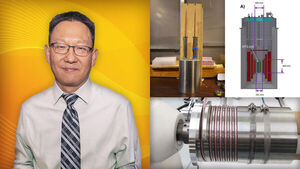
Smaller, stronger magnets could improve devices that harness the fusion power of the sun and stars
"Researchers at the U.S. Department of Energy’s (DOE) Princeton Plasma Physics Laboratory (PPPL) have found a way to build powerful magnets smaller than before, aiding the design and construction of machines that could help the world harness the power of the sun to create electricity without producing greenhouse gases that contribute to climate change. The scientists found a way to build high-temperature superconducting magnets that are made of material that conducts electricity with little or no resistance at temperatures warmer than before. Such powerful magnets would more easily fit within the tight space inside spherical tokamaks, which are shaped more like a cored apple than the doughnut-like shape of conventional tokamaks, and are being explored as a possible design for future fusion power plants. Since the magnets could be positioned apart from other machinery in the spherical tokamak’s central cavity to corral the hot plasma that fuels fusion reactions, researchers could repair them without having to take anything else apart. “To do this, you need a magnet with a stronger magnetic field and a smaller size than current magnets,” said Yuhu Zhai, a principal engineer at PPPL and lead author of a paper reporting the results in IEEE Transactions on Applied Superconductivity. “The only way you do that is with superconducting wires, and that’s what we’ve done.” Fusion, the power that drives the sun and stars, combines light elements in the form of plasma — the hot, charged state of matter composed of free electrons and atomic nuclei — that generates massive amounts of energy." [...]
Documentação
A documentação é parte essencial do processo de aprendizagem e a Internet além de artigos interessantes de explorar também tem alguma documentação em formato PDF interessante de ler. Todos os links aqui apresentados são para conteúdo disponibilizado livremente pelo editor do livro.
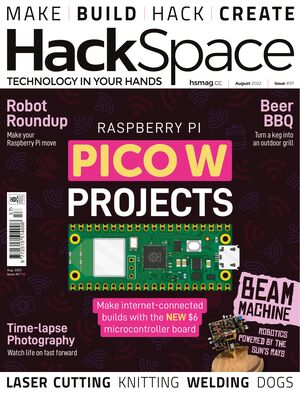
HackSpace magazine #57
"The Raspberry Pi Pico: it’s tiny, it’s fast, it’s versatile, and even more impressively these days it’s available. And now it’s got even better, with the introduction of the new internet-enabled Raspberry Pi Pico W. We’ll run through the capabilities of this little board, and get you started on the road to victory with a couple of choice projects. - Turn an old beer keg into a device for cooking meat - Harvest the sun’s rays to power a free-form soldered robotic sculpture - Visit a field full of geeks in Herefordshire (EMF Camp – it’s back!) - Program a thermal printing camera using Python" [...]
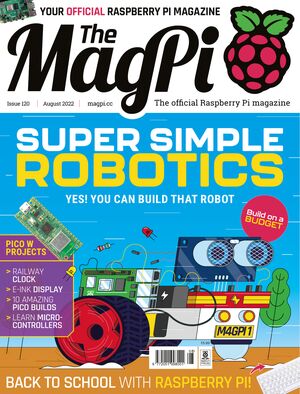
The MagPi 120
"Inside The MagPi magazine issue #120: - Super Simple Robotics. Get hold of low-cost parts and roll your own robot. Or, discover the best robotic kits money can buy. Everything you need to know about our metal friends can be found in this month’s edition of The MagPi - Pico W Projects. This issue is packed with ideas for things to make with the all-new Pico W board. Learn all about microcontrollers and build clocks, displays and other incredible projects." [...]
Projetos Maker
Diversos Projetos interessantes.
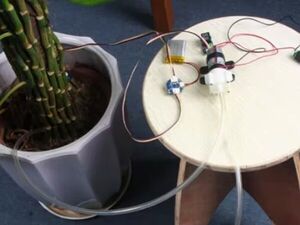
Plant Care System Based on Pi3 and Wio Node
"Wio Node is designed to simplify your IoT development, aims to make it easy to develop Internet of Things products and services. I always wanted to bulid a project that can control many nodes for Green house Irrigation System, but never found the right solution. The Wio Node is suitable for my project. Wio Node is designed to simplify your IoT development, aims to make it easy to develop Internet of Things products and services. It is an ESP8266 based open-source Wi-Fi development board to create IoT applications by virtualizing plug-n-play modules to RESTful APIs with mobile APPs. Compared to Wio Link, It's more small and cheaper." [...]
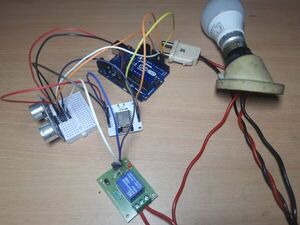
Multi-Featured Burglar Alarm using Bolt IoT
"This is home automation as well as a burglar alarm. You can set up it near your house door to notify you if any burglar enters your house. Burglary incidents in your area? No worries. Using the Bolt Wifi Module we will make a burglar alarm which notifies you if somebody enters your house at night. Also, this multi-functional system can turn your boring home into a smart home." [...]
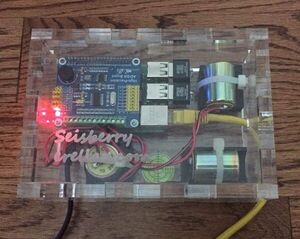
Seisberry
"The Seisberry in autonomous mode: 3 orthogonal broadband geophones, oriented North, South and Vertical; a Raspberry PI running Raspian Buster (green PCB); a HAT (Hardware On Top) blue PCB to perform AD (Analogic to Digital) conversion; one internal micro SD for the Linux OS; two external Micro SD memory to store the seismic data in raw format and Miniseed / Segy; a power supply, here instantiated as a 5V battery for autonomous use. For stationary use, the battery is replaced by a regular USB charger, like an iphone charge. The network connection (either wifi or cable) is used for communication with the device (sftp, VNC, http) and synchronization of the time server. For those eager to get going, head to the Seisberry Fast Build page. The basic build should take about 30mn if you have some previous Raspberry Pi project under your belt, maybe 1 hour if it is your first Pi project. I wanted a seismic node, fully open source, with 1 to 4 components, able to record either autonomously in the field and output SEGYs, or be used as an Iris seismic station recording mini-seeds and uploading to an Iris server." [...]
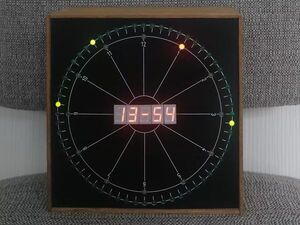
Digital 60+12 led clock
"Digital 60 led clock analog style with RTC DS3231 This is my first clock I made in 2004. I made the clock with digital ic's. I used 4 bit shift registers, so I had to use 33 of them. And to debounce 4 switches I used NAND gates to do the job. Also to make 1 Hz clock, I used several divider ic's to slow down the 1 MHz crystal. My father in law engraved the front." [...]
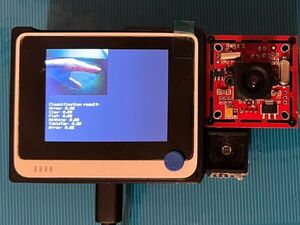
Hand exercises classification using Wio-Terminal
"Classification of rehabilitation exercises for people with arthritis. Practical aspects. Introduction Edge computing is a type of computing in which devices are located at the user's exact physical location. This allows the devices to interact directly with the user's source of information (data). This way, it is possible to acquire and analyse signals instantly without sending them over the network for analysis. This ease of access to the data source has been made possible because, in the last decade, these devices have evolved extraordinarily." [...]

TinyML Made Easy: Anomaly Detection & Motion Classification
"Exploring Machine Learning on a giant tiny device, the Seeed XIAO BLE. Sense. Introduction Microcontrollers (MCUs) are very cheap electronic components, usually with just a few kilobytes of RAM, designed to use tiny amounts of energy. They can be found in almost any consumer, medical, automotive, and industrial device. It is estimated that over 40 billion microcontrollers will be sold this year, and probably there are hundreds of billions of them in service nowadays. However, these devices don't get much attention because they're often only used to replace the functionality of older electro-mechanical systems in cars, washing machines, or remote controls." [...]

Arduino weighing machine(scale) with analog showing
"This is a Retro style weighing machine where the result is displayed on the Galvanometer instead of LCD Display. This time I will show you how to make a weighing machine where the result is displayed on the Galvanometer. Instead of a Galvanometer, we can use a 5V Voltmeter, but in that case the 10 k trimmer potentiometer should be removed. The electronic weighing scale uses a load cell which is a transducer that is used to create an electrical signal whose magnitude is directly proportional to the force being measured. This signal need to be amplified and processed, and that function is performed by a small breakout board with HX711 IC which is a 24-bit high precision A/D converter. Usually calibrating and the final result is displayed on an LCD display or on a serial monitor, but in this case I modified the standard code so that the calibration process is displayed via LEDs and the weight is displayed on an analog instrument." [...]
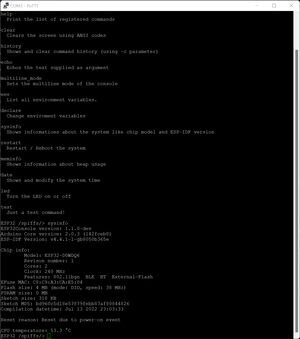
ESP32Console
"Arduino library to add a serial console to your ESP32 console. It includes some useful commands and allows to easily add your own custom commands. This easily allows you to control and configure your control via serial console in a comfortable and easy way. This library encapsulates the Console component included in the ESP-IDF and allows to use it in an easy "Arduino-way". Features - Simple to use - Navigatable history, autocompletion with tab for commands (when using an ANSI terminal) - Persistent history if wished (history gets saved across reboots) - Many useful commands included like showing infos about system, memory, network and more (see commands.md for more info) - Console works in its own asynchronous task, so you can use your arduino loop() function as you like - Support for environment variables and variable interpolation in commands - Easy to implement own commands - Easy to use argument parsing using cxxopts (see argparser example) - Customizable prompt - Ships a simple file editor to modify and create files locally on system if wanted" [...]

Hunt the Lunpus
"A hand-held 7-segment display game based on the ATtiny84. Based on the old Hunt the Wumpus text-based computer game originally published as BASIC source code in Creative Computing. The original is based on a dodecahedron maze but I first came across it as a grid-based cave game on the TI-99/4A we had as kids. This handheld version has been renamed Hunt the Lunpus for obvious reasons once you consider the constraints of the display wink" [...]

ESP8266 SMD to DIP adapter
"A breadboard-friendly adapter for the ESP-12 I've been using the ESP8266 on some development boards (Wemos D1, NodeMCU, ESP DevKitC, etc.) for a while now. But recently, I started to research how I could develop embedded systems beyond the Arduino framework. Thus I wanted to experiment with the ESP8266 RTOS SDK and have a way of toying around, so I figured out that using a breadboard is the way to go. But there's a significant problem. You can't solder some regular 0.1" pins to the IC." [...]

Autonomous Lawn Mower without GPS RTK
"Building a few cm precision without GPS RTK. What do you do, if you have a garden to mow, some spare Arduino devices and enthusiasm forembedded and control systems :) You build an Autonomous Lawn mower. If you are not fond of any of these and just want to get the garden mowed, then buy acommercial product, it is much more faster and easier, than building, codingand testing a system like this. Mechanical characteristics and wiring I built the mechanical parts of the mower from an old control cabinet. The PLC had to be removed and the cabinet itself could be used. To hold the motors an aluminum profile is fixed onto the bottom of the cabinet." [...]
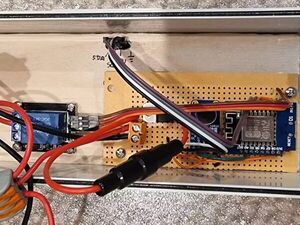
Sunset Switch - Overkill
"Over engineered sunset switch for exterior LED lights. Gets time of day and sunset time updates from web. Ode to the Wemos D1 Mini. Motivation We eventually got tired of the generic solar recharged lawn lights that light the edge of our driveway at night (they all eventually fail) and replaced them with a string of mains powered LED lights. Now we needed a sunset driven switch to automatically turn them on for a few hours after sunset every day. Time for some Wemos D1 Mini love and some overkill." [...]

DIY TP4056 Charging Module
"This project is designed to charge single cells Li-Ion/LiPo/LiFe with protection against overcharge and short circuits. Story Look, I'm charging! There are more than enough stories about batteries exploding due to overcharging. Too much stress on a battery can lead to a chemical reaction and boom! Your battery is history. With the DIY TP4056 Battery Charging Module you won't need to worry about that happening because this bad boy automatically shuts off once your battery is full." [...]

GRBL Based Coil Winder From Water Pipe
"When I was working on the Toy Magnetic Levitation project with a solenoid coil, I thought to myself, why didn't I make a coil winder. So I took my times to build a simple coil winder based on GRBL firmware and it was made from PVC pipes. I'm willing to share how I made it, please check out video below and let's get started. Main components: - 1pcs x Arduino Uno R3 - 1pcs x Arduino CNC Shield V3 GRBL - 2pcs x Stepper Motor Driver A4988 - 2pcs x Stepper motor NEMA 17 - 2pcs x GT2 6mm Closed Timing Belt 200mm - 2pcs x GT2 Timing Pulley 60 Teeth, Hole diameter 8mm - 1pcs x Round Bar Shaft Rod Diameter 8mm, Length 400mm - 3pcs x Round Bar Shaft Rod Diameter 8mm, Length 200mm - 1pcs x T8 Lead Screw 2mm Pitch, 8mm Lead , Length 400mm with Copper Nut - 16pcs x F608ZZ Ball Flanged Shielded Bearings 8 x 22 x 7mm - 2pcs x XH2.54mm – 4P Wire Cable Double Connector - 1pcs x 5mm DC Female Power Plug - 1pcs x Power Supply 12VDC - 1pcs x Clear/White Acrylic, size A3, thickness 5~10mm - 1pcs x Empty plastic spool. I reused empty plastic spool that is used to coil the soldering tin wires. - 2pcs x Small Rubber Guide Roller V type." [...]

pico-zxspectrum
"This is a basic 48k/128k ZX Spectrum emulation on the RP2040 with DVI/LCD/VGA output. Features - DVI over HDMI (Wren's Amazing PicoDVI) - LCD support (ST7789 320x240) - VGA video (RGB332, RGB222, RGBY1111) - USB Keyboard & Joysticks - PS/2 Keyboard - PWM/I2S DAC audio for ear, mic and AY-3-8912 - 12 quick save slots - Load from .z80 snapshot files - Read from .tap tape files - On screen menu system - Kempston and Sinclair joystick emulation Supported Boards - Breadboard - RetroVGA - PicomputerMax - PicomputerZX - Pimoroni Pico DV Demo Base" [...]
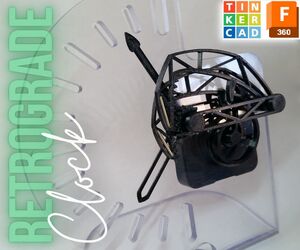
Build Your Own Retrograde Clock!
"In this Instructable I would like to show you guys how to create your very own cool steampunk looking retrograde clock.I LOVE weird intricate clocks and this one is definitely up there with my favourites, and it's easy to make too!I started making the clock with Tinkercad but after making the clock face I had to switch to Fusion 360 to design the more intricate details of the gears and arms... and get some pretty awesome renderings in the process too! " [...]
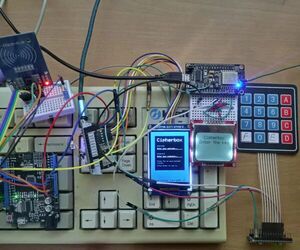
Cipherbox V2.0
"A while ago, I made the first version of the Cipherbox. In my opinion, it was already resembling a fortress, but it was in no way flawless. It had two serious vulnerabilities: 1) Absence of the integrity verification feature; 2) Receiver's vulnerability to the replay attack. I've fixed these vulnerabilities in this version of the Cipherbox, which of course, in no way made the Cipherbox perfect, but at least it's a bit better now. If you missed the previous tutorial, let me remind you that Cipherbox is what I consider to be a cryptographic swiss knife. It utilizes six encryption algorithms, and it's also a vault that's locked with four RFID cards, your username, and password." [...]
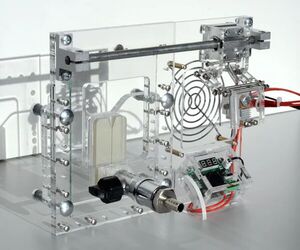
Vacuum Fiber Molding (VFM) Machine
"This instructables guides you through the steps of making a Vacuum Fiber Drawing (VFM) machine, a tool to designed for chemists/soft-roboticists/academics to rapidly design and iterate LCE actuators. Tools needed: - Laser cutter - 3D printer - Screwdriver - Glass drill - superglue - hot glue - wirestrippers Parts needed: - 5mm perspex - Glass pane +/- 10x15cm (max 2 mm thick) - Fan guard +/- 9x9cm - XH-W1209 thermostat - Female DC Jack - 12V 3 amp powersupply - Regular 3D printer heater block with M6 thread - 6mm heater cartridge - 1/2" xM24 air valve - 1/2" coupling - 1/2" hose connector - Linear bearing SCS8UU - 8mm by 235mm metal rod - 8mm rail support - Spring 10x15mm (4x) - Tensionspring 5x15mm - Neodymium magnet 10x2mm (5x) - Heat sink +/- 1x1cm - Breadboard +/- 10x30x2mm - felt - zipties - Nylon Bolt M3x8 (4) - Bolt M3x20 (28x) - Bolt M3x60 (6x) - Bolt M3x25 (4x) - Bolt M3x8 (4x) - Spacer M3x20 (4x) - M3 nut (44x) - M3x10 Nylon spacer (2) - M3x20 metal spacer (4x) - Bolt M5x20 (4x) - M5 nut (4x) - Coach bolt M6x60 (4x) - Bolt M6x12 - M6 nut (4x) - Silicone" [...]
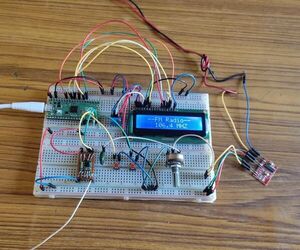
Raspberry Pi Pico and TEA5767 FM Radio
"In this Instructables we are going to make a FM radio receiver using raspberry pi pico and TEA5767 FM receiver chip. Here I am using micropython programming language to program the Raspberry pi pico. lets get started! List of hardware: - Raspberry pi pico - TEA5767 FM receiver chip - HD44780 LCD (16*2, blue back color) - Pushbutton - PAM8403 Class-D Stereo power amplifier module - Bread board--2 - Jumper wires - Resistors (1K—2, 10K—1, 100--1) - Capacitors (0.1UF) - Potentiometer (10K) - Multiturn potentiometer(10K) - Speaker (4-ohm, 3W) - Micro-B USB cable" [...]
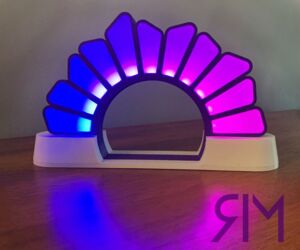
Smart UV Index Display
"Ultraviolet light is invisible to the human eye but has some very important aspects to it. I wanted to create a display that provided a better way to track the UV index throughout the day. Utilizing the Open Weather API, the display is capable of displaying real time weather information. As a bonus, it also doubles as a beautiful art piece that changes with the sun. I chose purple for my design because it represents the color of UV light Most of the project's cosmetic design revolves around 3d printing. However, with the necessary electronics and a little bit of creativity, this project can be replicated with household items." [...]

Twitch Livestream Controlled Delivery Robot
"Hello! I am Sunayana Pai, an interdisciplinary engineering junior at San Jose State University. I'm working with Andrew Duong, a mechanical engineering senior. Inspired by the popular Twitch Plays Pokemon (where viewers of a stream sent commands for the game's character to follow) and various delivery robots on the market, we wanted to create a entertainment in the form of a delivery bot the viewers are challenged to control. If you've never heard of Twitch, it is a live broadcast in which people can watch and chat in real time! We decided to call this robot TOADS, which stands for Twitch Operated (Internet) Accessible Delivery System!" [...]
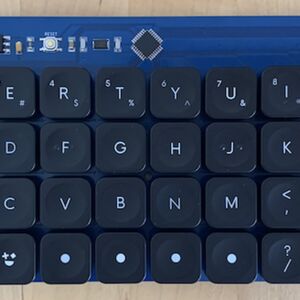
Ortholinear Keyboard Matas v1.0
"Programmable ortholinear keyboard very low profile with RGB light This is another mechanical keyboards compatible with qmk framework, the others seem very tall and uncomfortable to me, and I wondered why there isn't a low profile one? and I asked myself again, what if I make one? here I leave my work done in two years and in my free time. The keyboard has the name of my son, he was amazed with the colors and the sound of the keys. " [...]
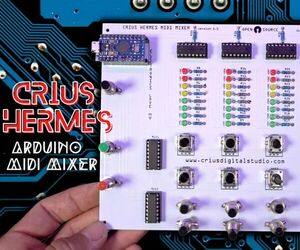
DIY Arduino MIDI Mixer "Crius HERMES V1.0"
"Hi! I am Crius and I LOVE MIDI Controllers! The last couple of years I started learning about electronics from nothing to be able to build my own MIDI controllers that would serve my needs , taste and be cheaper overall in comparison with the branded products. The Crius HERMES MIDI Mixer consists of 8 potentiometers and 11 buttons with which we can control parameters of the VST-Plugin or DAW we play music and 32 LEDs divided into 4 columns (i.e. 8 LEDs for each track) that show us live the Volume value of each track within the DAW program by turning on the corresponding LEDs in each column. Of the 11 buttons, 8 can be assigned to any DAW parameter we want." [...]
Secção Videos
Videos interessantes.
That's all Folks!



